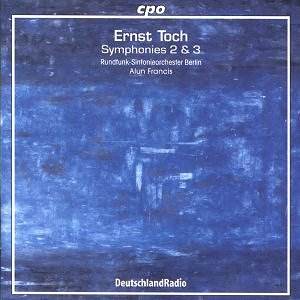Reviewing the Buchberger String Quartets of Toch’s
Eleventh and Thirteenth Quartets (also
on CPO, 999 687-2), I confessed to being bowled over by the composer’s
seeming super-abundance of invention, and towards the end of my review
I referred to this disc, originally issued in 2000. It would indeed
appear that the symphonies are as worthy of consideration as the quartets.
Toch’s symphonies are products of his compositional Indian Summer: the
Second was composed in 1951; the Third in 1955. The Second is dedicated
to Albert Schweitzer, and Toch added the words, ‘I will not go until
you bless me’ from Genesis after completion. It is scored for
standard orchestra, to which two harps, organ and piano duet are added.
The musical argument is taut and serious, the mood frequently angst-ridden.
The very opening of the symphony sets the scene perfectly: distorted,
arresting fanfares capture the attention, and Toch’s closely argued
structure never allows the concentration to drop. The mastery of counterpoint
is particularly impressive.
The performance is good. Only a bad trumpet split that
should have been re-taken two minutes into the piece betrays a lack
of available studio and/or editing time. Much more important is the
way Francis and the Berlin Radio Symphony Orchestra capture the shadowy
nature of the scherzo (‘sehr leicht’) and the way they follow the tempo
direction of the Adagio to show it in the best possible light: ‘Adagio
ma non strascinare,’ Adagio, ‘but not dragging’.
The Third Symphony of four years later won a Pulitzer
Prize in 1956, having been commissioned to celebrate the 300th anniversary
of the founding of the Jewish community in the United States. Here Toch
adds a Hammond organ and ‘glass balls’ to the orchestra (a vibraphone
may be substituted for the latter), as well as some new instruments,
like the ‘rotarion’, a wooden box containing wooden balls which makes
a rumbling sound when moved. Toch saw himself continuing the line of
Richard Strauss (who has used a wind machine in his Alpine Symphony)
and Antheil (who had used aeroplane propellers as part of his armoury).
The Third Symphony was premièred by the Pittsburgh Symphony Orchestra
under William Steinberg, and a recording by them briefly appeared in
the UK on EMI Matrix CDM5 65868-2. If anything the Third inspires Francis
and his orchestra to even greater heights. The ‘march’ of the first
movement is simply stunningly played, as is the Andante tranquillo second
movement. The finale, marked ‘Allegro impetuoso’, is imbued with a busy
energy (it also contains another angular call-to-arms).
All in all this is a superb disc of wonderfully fascinating
music just waiting to be discovered. Perhaps there is even more freedom
of compositional imagination in the string quartet disc mentioned above,
but that does not make these symphonies any less riveting.
Colin Clarke
see also
Toch cello works


